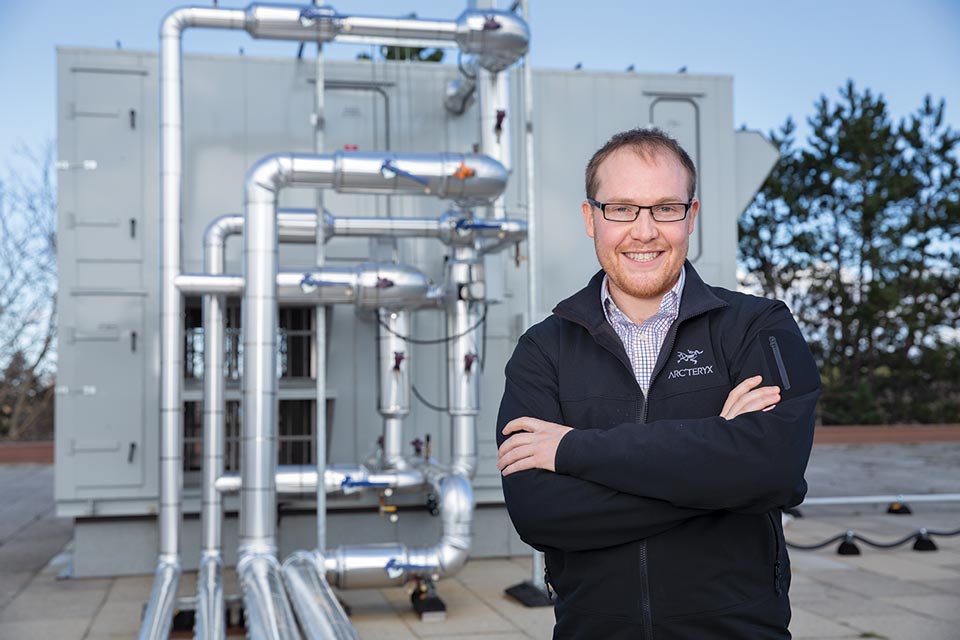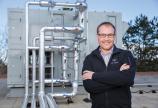David Adams: Energy Manager
- Melanie Groves

Bringing the Strategic Framework to life
A new series of articles explores how staff and faculty across campus are implementing the university’s Strategic Framework.
David Adams, Energy Manager
Facilities Management
Tell us about your work at the university.
I am the energy manager in Facilities Management, I see myself as the ‘energy accountant’ for the campus. We are a staff of two in the energy management program, and we’re looking to add another person soon. Our objective is to reduce the environmental impact of fuel, natural gas, electricity and water use on campus. It’s a diverse role and I get involved in a lot of different things, including monitoring campus energy use, conservation projects, working with staff to tune up the energy systems in campus buildings, sustainability committee work, and strategic planning to create a long-term strategy for campus energy use, particularly to target deep reductions in greenhouse gas (GHG) emissions.
Some projects have a much bigger impact than I expect. For example, updating the shower and sink fixtures in the residence buildings to low-flow faucets in 2018 has resulted in savings of 7 million litres of water a year. That’s huge, and we’re looking to expand that project to the rest of campus.
The District Energy Plant is another good example. It’s a high-efficiency system that will be the backbone of the campus heating system when it comes online this spring. It’s expected to result in about a 10 per cent reduction in energy use and GHG emissions.
How do you see the Strategic Framework helping or connecting to your work, and the work of your unit?
I think it gives us support and commitment from the highest levels of the university. We use it as a reference in our service and work plans, and it guides our decision making. The framework also helps us to fine-tune and prioritize those decisions. All of our planning in the future will point to the framework. When we come to update the Sustainability Action Plan we’ll certainly be looking at the Strategic Framework for guidance.
I keep a printed copy of the Strategic Framework strategies on my bulletin board to remind me of what we’re working toward. The framework helps set the agenda for me, particularly the “Promote Sustainable Futures” section (strategies 5.1-5.5). Planning for energy use is a long-term activity, and the framework holds me to a commitment to meet the “highest standards of sustainability.”
It’s a huge achievement that the new student housing and dining facility will be designed to Passive House standards—using 80 per cent less energy than standard buildings. It sets a precedent and is anticipated to be the largest Passive House building in Canada. Even with a net increase of 660 new beds, we’ll see a net reduction in energy use and GHG emissions because the new buildings are so much more efficient than the buildings they’re replacing. This shows great leadership, which is directly linked to the Strategic Framework.
Does the work you do correspond to particular strategies in the framework?
I think about all of the “Promote a sustainable future” strategies. Strategy 5.5 points to financial sustainability, and I spend a lot of time considering how to reduce the university’s greenhouse gas emissions in a financially feasible way. We have to take a holistic perspective to help us decide over the long term where to expend resources to optimize energy use. You can’t control what you can’t measure, and quantifying energy use provides clarity for the decision-making process.
Related to strategy 5.4, I engage with students in the Faculty of Engineering on sustainable design projects. In one class we asked students to design a carbon-neutral campus where I provided the energy and infrastructure data and greenhouse gas reduction targets. It’s a really interesting way of giving students an idea of what the realities and constraints are when it comes to energy management.
I’ve worked with masters students who have received funding from the Campus Sustainability Fund to look at technology that can reduce campus GHG emissions. Viable options include using biomass as a heat source for the campus, or converting to electric heat pumps instead of natural gas. Students in future classes will continue to refine these ideas, and it’s a valuable way for them to learn about both social and environmental sustainability.
I’m also working with the Faculty of Engineering and the Institute for Integrated Energy Systems (IESVIC) on a potential partnership for a large-scale grid battery system, a sustainable energy microgrid that will help reduce electricity use at times of peak demand and save money. This world-leading research (strategy 5.1) in energy storage has promising off grid-applications that, coupled with renewable energy, could potentially power remote communities.
We’ll also continue to consider partnerships with BC Hydro, FortisBC and other agencies (strategy 5.5) that can assist us in implementing energy conservation projects.

